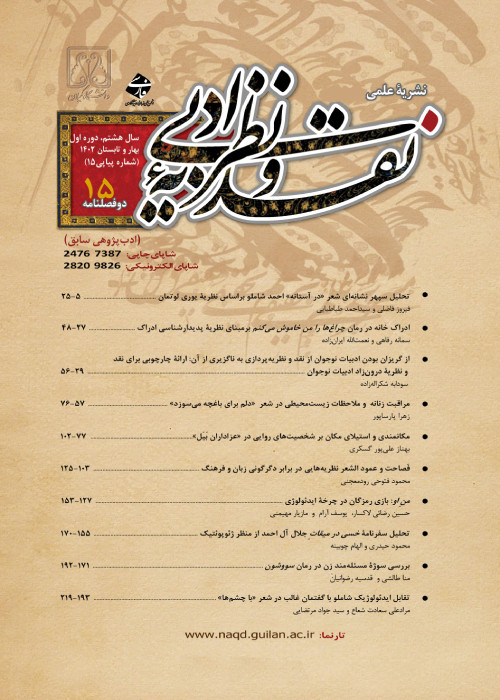Reading Ahmad Shamlou’s “Dar Astaneh” in Light of Yuri Lotman’s Notion of the Semiosphere
Yuri Lotman’s ‘semiosphere’ refers to an abstract enclosed space in which signs possess their meaning. What is placed within the boundaries of this sphere possesses culture and internal order. On the other hand, the outside is an extra symbolic or non-symbolic disordered and chaotic space in which the semiotics cannot be defined. Lotman believes that the semiosphere is in constant change due to mechanisms such as exclusion and absorption at the borders. Shamlou’s “Dar Astaneh” is a long poem, written in the late stages of his life, which summarises his philosophical and religious views regarding life, death, and the afterlife. This article employs Lotman's theory of cultural semiotics to analyse the semiosphere of the poem. The analysis concludes that Shamlou excludes metaphysical elements from the semiosphere, highlights distinctions between humnan and non-human natures, and celebrates human centrality.
Yuri Lotman’s ‘semiosphere’ refers to an abstract enclosed space in which signs possess their meaning. What is placed within the boundaries of this sphere possesses culture and internal order. On the other hand, the outside is an extra symbolic or non-symbolic disordered and chaotic space in which the semiotics cannot be defined. Lotman believes that the semiosphere is in constant change due to mechanisms such as exclusion and absorption at the borders. Shamlou’s “Dar Astaneh” is a long poem, written in the late stages of his life, which he regarded as his literary will and which summarises his philosophical and religious views regarding life, death, and the afterlife. It deserves to be investigated in Shamlou’s and contemporary Persian studies.
Under the influence of Saussurean semiotics and Max Webber’s definition of culture, Yuri Lotman theorised cultural semiotics. He defines language and culture as two modelmaker systems. He classifies these two concepts under the semiosphere, which is the only sphere that defines language and communication. Semiosphere presupposes any text or defined language as if it created a broader system, outside which language could neither exist nor function. The fundamental characteristic of the semiosphere is creating boundaries that translate data to comprehendible information. In other words, the semiosphere is a spatial model with demarcations. Its identity is defined in comparison to what falls outside its borders. The self/other or text/no-text confrontations are in accordance with sign positioning in the sphere. The semiosphere is in no case a fixed system. It changes through interaction, confrontation, exclusion, and absorption.
This analytical-descriptive study employes Lotman’s conceptualisation of semiotics.
4.1 Excluding Metaphysical Elements
At the start of the poem, some signifiers are put aside from the poem’s semiospherical intellectual field. This process activates the otherness and exclusion in the poem. The poet highlights the elements which he believes are not from his culture and must be excluded from the semiosphere. Shamlou introduces these elements to the reader through a chain of negative statements. As a result, we can argue that the excluded elements have already been present in the semiosphere and function through the process of naturalisation.
4.2 Nature and No-nature Distinction
In the second part of the poem, Shamlou depicts a journey from the “outside” to the “inside.” In other words, it is a process of subjectification and identification which makes the poet capable of gazing at all the elements of the world. Lotman regards nature as something not yet humanised or historicised. In this sense, historicity is the concept which can change and influence its surroundings. Verbs and cognitive processes employed in the poem explicate the transition from the observed to the observer.
4.3 Semiospherical Core of the Poem
The moment the poet distances himself from the elements of nature, he makes himself distinct from water, soil, plants, and beasts and defines his creation as “the magnificent body of man,” he makes ‘humanness’ the center of distinction. Then he explains the man who, from Shamlou’s point of view, aims to understand and give meaning to the world. In other words, nature and no-nature are defined in accordance with their identifying or defining capabilities. Also, the innate characteristics of the ‘self’ are defined through the perception of these ‘others.’ The poet continues to discuss other human characteristics.
Shamlou employs exclusion to remove metaphysical elements such as ghosts, phantoms, saints, devils, and Ifrits from the semiosphere. He uses adjectives such as lawless, negative, and chaotic to signal the chaos and disorder that characterise metaphysical elements. He mixes commonplace descriptions with a lofty language to satirise characters and highlight a sense of primitiveness in the aforementioned beliefs. In other words, he tries to complete the process of othering. In the second stage, Shamlou, by emphasising the non-human borders, which are identifying and defining capabilities, highlights his distinction as an element of no-nature against nature. Lastly, he introduces man as the semiospherical core and underscores the centrality of human beings.
- حق عضویت دریافتی صرف حمایت از نشریات عضو و نگهداری، تکمیل و توسعه مگیران میشود.
- پرداخت حق اشتراک و دانلود مقالات اجازه بازنشر آن در سایر رسانههای چاپی و دیجیتال را به کاربر نمیدهد.


